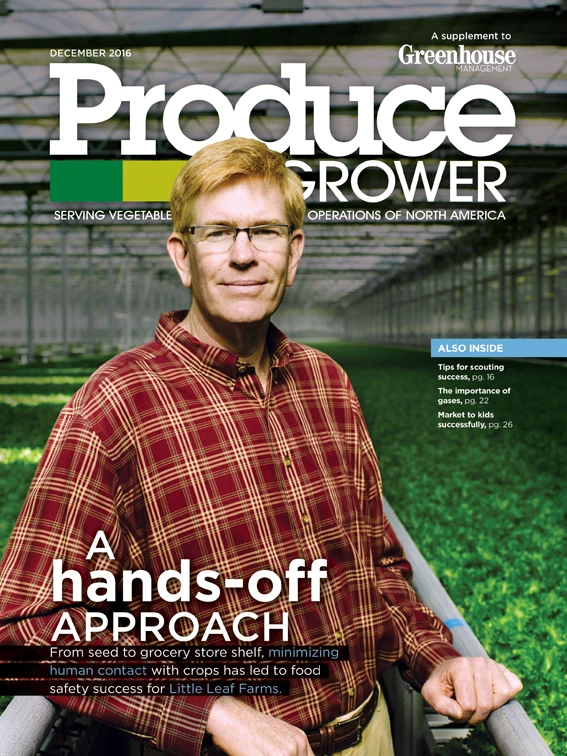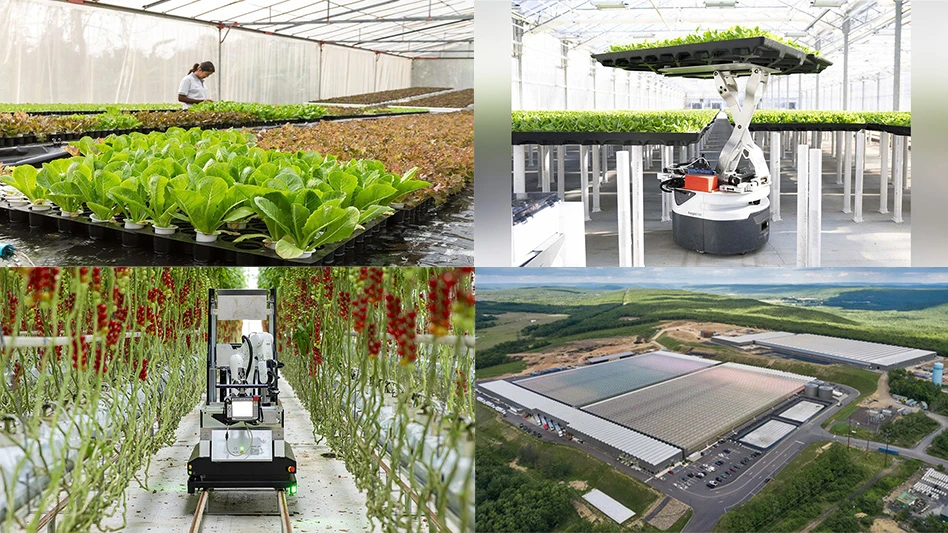
We have reached our sixth and final article in the 2016 Hydroponic Production Primer series. Previous articles have focused on production systems, water, nutrition, light and temperature. However, there is another aspect of hydroponic and controlled-environment food crop production that is less appreciated because it can be difficult to see or feel — atmospheric gases. There are several gases that we need to keep in mind when producing hydroponic crops in controlled environments, including carbon dioxide (CO2), oxygen (O2) and water (H2O).
Carbon dioxide
Carbon dioxide is the precursor to the carbohydrates that are fixed through photosynthesis. When CO2 concentrations in the growing environment decrease, the growth and productivity of your crops diminish. The less carbon that is available from CO2, the less there is that can be converted to carbohydrates, which ultimately are used for growth or stored. This highlights one of the reason CO2 management can be critical for food crops: Unlike ornamental plants, which are sold by units, food crops are frequently sold by weight.

The outdoor, ambient atmosphere contains about 400 ppm CO2. When greenhouses are being ventilated and outdoor air is frequently being introduced into the greenhouse, the CO2 concentration in the greenhouse can be similar to outside. However, CO2 concentrations can decrease to concentrations below 400 ppm when the greenhouse is not being ventilated. This occurs mostly in the winter when cooling is not required to maintain the desired air temperatures in the greenhouse. When light levels are strong, CO2 concentrations can decline quickly if plants are actively growing in the greenhouse, since uptake is increased.
To improve the growth and productivity of crops, CO2 can be added inside the greenhouse. When increasing CO2 concentrations, it is common to not simply increase concentrations to the point of ambient (~400 ppm), but to increase the concentrations to 800 to 1,000 ppm. A simple way to think about it is by looking at CO2 as you would a fertilizer. We don’t think twice about providing 12 macro- and micronutrients to our plants on a regular basis, and we can view CO2 similarly — low concentrations can slow growth, so we can increase concentrations to improve growth.
There are two methods of injecting CO2 into a greenhouse: 1) burners or 2) liquid. Each of these methods has advantages and disadvantages. Burners can be simple to install and use (Fig. 1). However, it is extremely important to monitor their function to avoid undesirable gases for both plant growth (ethylene) and human safety (carbon monoxide). Liquid CO2 can also be used, but you will need to check if you can store the tank properly, and be prepared to pay tank rental fees.
As previously mentioned, CO2 can be limited when greenhouses are venting less — from the later fall, through winter, into early spring — for many locations. The use of CO2 should only occur when vents are closed. Otherwise, the CO2 introduced into the greenhouse can be lost. Once the venting season has begun for cooling, you’ll want to reduce or discontinue the use of supplemental CO2, as the costs increase when it is more challenging to contain the CO2 in the greenhouse.
Oxygen
Another gas to keep in mind is oxygen. For traditional greenhouse crop production, there is little to no concern about oxygen concentrations during production. While the same is true for hydroponic production atmospheres, it is important for nutrient solutions in nutrient-film (NFT) and deep-flow technique (DFT) systems. Adequate oxygen concentrations need to be maintained in these systems where roots are partially or completely submerged in nutrient solution.
A few different factors affect dissolved oxygen concentrations. First, the production system you use affects O2 concentrations. NFT systems will contain higher concentrations of dissolved oxygen because the nutrient solution is aerated as it is passed through channels, drained into the nutrient reservoir and recirculated. Alternatively, O2 concentrations in nutrient solutions for DFT systems can diminish more quickly, since there is no agitation of the nutrient solution to incorporate O2.
In addition to production systems, the temperature of the nutrient solution affects dissolved O2 concentrations. The solubility of O2 in water decreases as water temperature increases. This is especially important for DFT systems in the summer, as they have a larger volume of water or nutrient solution per plant. This increases the capacity of the system to hold heat.
Another factor that can affect dissolved O2 concentrations is the size of the bubble used for aeration. The smaller the bubble that is introduced into nutrient solution, the higher the O2 concentrations. This is due to the fact that, with smaller bubbles, the amount of surface area relative to the volume of gas is high compared to larger bubbles, and more surface area increases the solubility in solution.
H2O
Our final gas we need to consider is water vapor. The amount of water vapor is measured as relative humidity or vapor pressure deficit. Water vapor or humidity can impact the growth and development of plants as well as pathogens.

When humidity is high, plants diminish their transpiration. One of the biggest problems associated with low transpiration is tip burn on lettuce. Since calcium is taken up passively when plants take up water, less water uptake also causes less calcium uptake. This is why air movement, which reduces humidity around shoot tips, is used to reduce tip burn of lettuce.
In addition to water use and nutrient uptake, humid environments can favor the development of pathogens. Powdery mildew and botrytis are two pathogens that can thrive in humid environments. One of the best methods to reduce humidity in your greenhouse is to vent at night when you are heating, as this practice will help expel humidity from inside the greenhouse.
Take-home message
While we can see light and feel temperature, gases may be a less obvious component of the growing environment. However, they are no less important! Consider using CO2 enrichment to boost the productivity of your crops. Keep nutrient solutions well aerated to promote healthy root growth and development. Minimize humidity in the greenhouse to discourage pathogen development and enhance transpiration. These actions will all contribute to a more productive hydroponic crop.
ccurrey@iastate.edu
Explore the December 2016 Issue
Check out more from this issue and find your next story to read.
Latest from Produce Grower
- Cox Farms partners with Feeding America to tackle food insecurity
- Ethical labor practices supported by third-party certification programs
- Relationship building
- Growing small to trial leafy greens
- IFPA expands team, launches strategic plan
- Downy mildew
- Thought Leaders to Share Insights at Clemson FRESH Food, Packaging & Sustainability Summit
- Ventilation optimization





